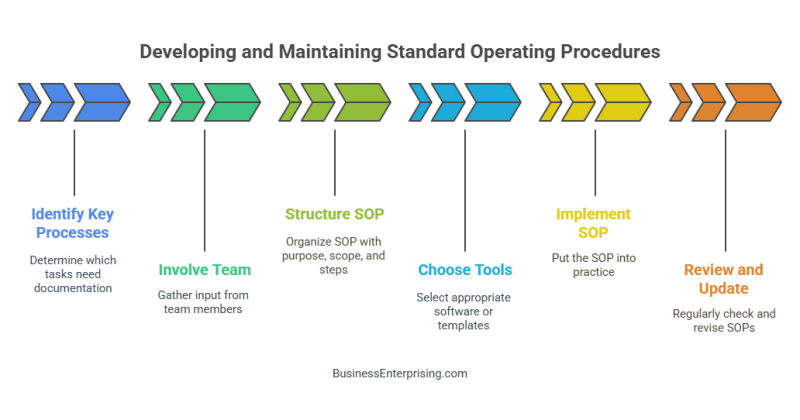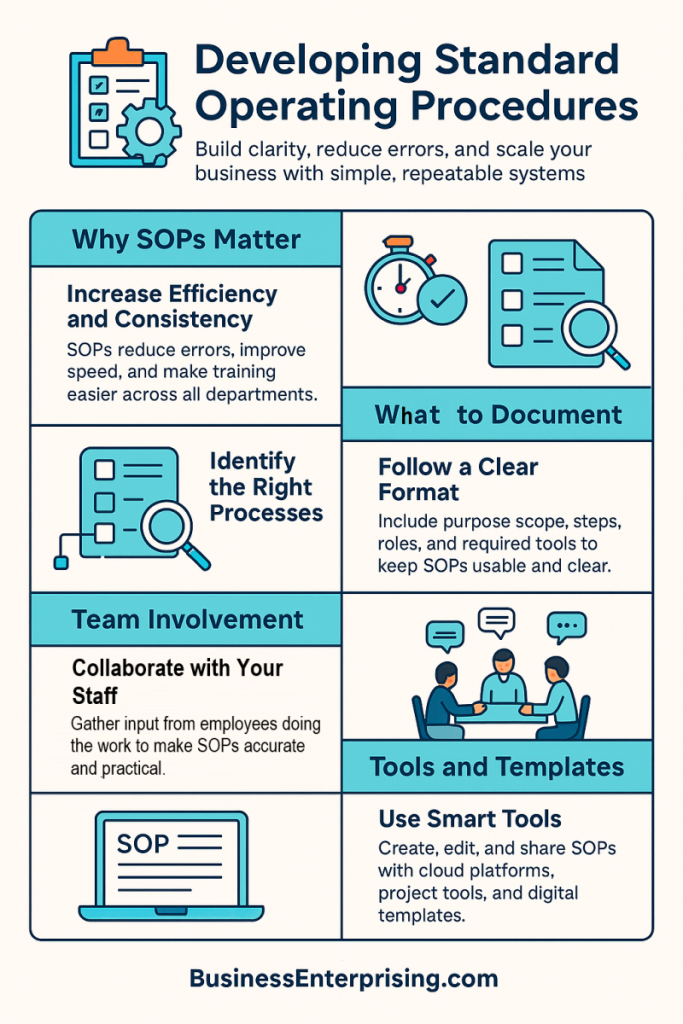
Additionally, written procedures reduce mistakes. If everyone follows the same steps, your service stays steady even when roles shift or people leave. That reliability builds trust with customers and helps new staff get up to speed. However, not all tasks need the same level of detail. You must choose what to document and how.
Your process doesn’t need to be perfect. Start with key activities that affect customers, money, or quality. Then build from there. Additionally, get input from the people doing the work. Their feedback keeps your SOPs realistic and useful.
Good SOPs don’t sit in a folder collecting dust. They guide actions, answer questions, and reduce confusion across departments. Therefore, use tools that make editing and sharing easy. The simpler it is to update a process, the more likely it stays relevant.
Whether your team is growing or just trying to stay organized, SOPs help. With clear steps in place, you create more stability and less stress. Building these systems takes effort up front, but they save time and trouble later. That tradeoff is worth it.
Why SOPs Matter for Business Efficiency
Clear systems help businesses run smoothly, especially during growth or staff changes. Developing standard operating procedures gives your team a foundation. When everyone follows the same steps, tasks get done faster and with fewer mistakes. Therefore, you waste less time fixing errors or explaining things more than once.
Additionally, SOPs help new hires get up to speed. Instead of relying on memory or guesswork, they follow documented steps. This reduces confusion and makes training more consistent. As a result, your business operates with less downtime and fewer performance gaps.
You also improve cross-team communication. When each department uses a standard process, it becomes easier to coordinate and complete shared tasks. Therefore, fewer things fall through the cracks. Managers can also track performance better when workflows are predictable and repeatable.
However, the benefits go beyond day-to-day tasks. Documented procedures make it easier to delegate, outsource, or scale operations. You don’t need to pause everything just to expand or shift responsibilities. Additionally, SOPs give you a record you can audit and improve over time.
If your business feels disorganized or stretched thin, start by reviewing your key activities. Then consider which ones need structure. Developing standard operating procedures takes time upfront, but it pays off in clarity and control. You reduce stress, speed up results, and make your business easier to manage. Consistency becomes your advantage, not a struggle.
Identifying Processes That Need Documentation
Not every task in your business needs a formal procedure. However, some processes benefit more from clear, written steps. These are the tasks that repeat often, involve multiple people, or affect customers directly. Therefore, you should start by identifying those high-impact activities.
Additionally, look at areas where mistakes happen regularly. If your team frequently asks questions about a task, it likely needs documentation. You can also check for bottlenecks or missed steps. These usually point to gaps in consistency. Developing standard operating procedures helps reduce those errors and speeds up daily work.
Some processes involve risk or compliance. These should be a priority. If done wrong, they may lead to fines, delays, or lost clients. Therefore, documenting them gives your business protection and a clear point of reference. You can’t fix what you haven’t defined.
However, don’t try to document everything at once. Start with the most important or time-consuming tasks. Focus on what creates value or prevents problems. Additionally, ask your team for input. They often know which steps cause confusion or slow things down.
Once you’ve made a list, rank each task by frequency, impact, and complexity. That gives you a clear starting point. Developing standard operating procedures becomes easier when you know where to begin. You’ll see improvements faster and avoid wasting time on low-priority items. Clarity starts with smart choices, not more paperwork.
Step-by-Step Structure of an Effective SOP
A good SOP keeps things clear, consistent, and repeatable. To get that result, you need a simple, organized structure. Start with the purpose. This section explains why the task matters and what it aims to achieve. Therefore, anyone reading it knows the point before reading the steps.
Next comes the scope. Define where the procedure applies and who it covers. You might limit it to one department or a specific situation. Additionally, note any tools or systems needed to complete the task. That way, no one gets started without the right setup.
The core of the SOP is the step-by-step procedure. Use clear language. List each action in order and keep it simple. Therefore, no one guesses what comes next. You want the process to be easy to follow, even under pressure.
Additionally, name the people or roles responsible. This avoids confusion and missed steps. If a task needs sign-off, say who must give it. If someone tracks results, list them. You make the work easier when everyone knows their role.
Include references if needed. You might link to forms or tools used in the process. However, keep them relevant and updated. Developing standard operating procedures is not about over-explaining. It’s about making tasks repeatable and easy to complete.
If you stick to purpose, scope, steps, and roles, your SOPs stay clean. That structure supports growth, training, and quality without adding complexity.
Involving Your Team in SOP Development
Getting your team involved makes SOPs more useful and easier to apply. The people who perform the tasks every day know the details. Therefore, their input helps you catch things you might miss. You also avoid writing steps that sound good on paper but don’t work in practice.
Additionally, involving your team builds buy-in. When people help create something, they are more likely to follow it. They feel heard and respected. That leads to fewer complaints and better results. However, you need to ask specific questions. Focus on what slows them down or causes repeat errors.
You may find that what’s written doesn’t match how the task gets done. That’s not unusual. Therefore, use these discussions to correct and simplify steps. Make it easier, not harder, for people to succeed. Developing standard operating procedures should support your team, not burden them.
Hold short meetings or work sessions to gather feedback. Ask team members to walk you through their process. Additionally, let them test early drafts of the SOPs. You’ll catch unclear steps faster this way and fix issues before they cause problems.
The more practical your SOPs are, the more likely your team will follow them. Collaboration keeps things grounded and relevant. Your role is to guide the process, not control it completely. When your team helps build the system, it becomes something they own and use with confidence.
Tools and Formats for Creating SOPs
Using the right tools helps you document faster and keep things organized. Spreadsheets and word processors are a simple place to start. However, these basic tools can make updates harder later. Therefore, many businesses now use dedicated SOP software or project management platforms.
Additionally, templates save time. You don’t need to start from scratch each time. Look for templates with fields for purpose, steps, and assigned roles. This keeps everything consistent and easy to follow. Some software even includes checklists that help teams stay on track.
Cloud-based tools offer added benefits. You can access, edit, and share SOPs from anywhere. Therefore, remote teams can stay aligned without long email threads. You also get version control, which avoids confusion from outdated documents.
Project management apps can also help. Tools with task tracking and attachments let you pair instructions with real tasks. That gives your team one place to work from. Additionally, video tools can record steps and save time writing. Some tasks are easier to show than explain.
When developing standard operating procedures, pick tools that match your team’s habits. If your team uses one platform daily, keep your SOPs there. That way, they stay visible and easy to update. You don’t need the most advanced tool. You need one that people will actually use. Simple, accessible systems get the job done.
Maintaining and Updating SOPs Over Time
Once you create an SOP, your work isn’t finished. Business needs shift, tools change, and people rotate through roles. Therefore, you must treat SOPs as living documents. Reviewing them often keeps your team aligned and your operations accurate.
Additionally, updates help prevent confusion. Outdated steps cause mistakes or slowdowns, even if your team follows instructions. You may not notice issues right away. However, small problems often build up until they affect results. Regular checks help you catch those changes early and fix them fast.
Set review dates based on how often the task or system changes. Some SOPs stay stable for months, while others shift each quarter. Therefore, adjust your schedule to match the pace of your business. You can also assign someone to own each SOP and track updates.
Involve your team in the review process. They will know if a tool no longer works or if a step became unnecessary. Additionally, listening to feedback helps your SOPs stay practical and easy to follow. That saves time for everyone who uses them.
Developing standard operating procedures only adds value when they reflect how your business truly operates. If your process changes but your documents don’t, confusion follows. A clear, current SOP helps everyone do their job with less friction. That keeps your business efficient, even as things evolve.
Conclusion
SOPs help your team work smarter, not harder. They bring clarity to routine tasks and reduce wasted time or repeated errors. However, creating them is not a one-time project. You need a system that supports consistency while allowing for changes.
Additionally, your team plays a big role in making SOPs useful. When employees help build and improve procedures, adoption improves. Therefore, listen to their feedback and adjust when needed. Small updates can keep things accurate without starting over from scratch.
The right tools also make a difference. Whether you use templates or dedicated platforms, keep access simple and updates easy. If SOPs are hard to find or follow, people will stop using them. Developing standard operating procedures should improve workflows, not slow them down.
As your business grows, your SOPs must grow with it. Regular reviews and edits keep everything aligned with your goals. Therefore, build time into your schedule for maintenance. The better your documents reflect how work gets done, the smoother your operation runs.
You don’t need to build everything at once. Start with what matters most. Focus on tasks that affect customers, cash flow, or compliance. Then work your way down. Over time, your SOP library will become one of your most useful tools. Keep it simple, keep it relevant, and keep it up to date.



